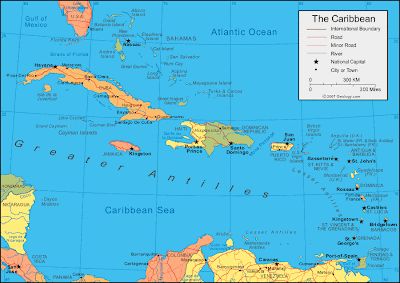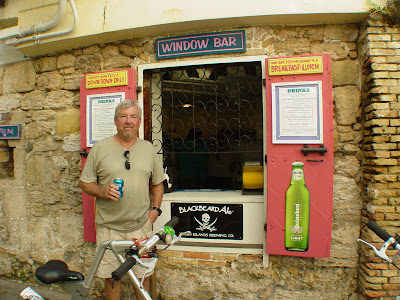The Bahamian dollar (BSD) is pegged to the U.S. dollar (USD)
on a one-to-one basis. All of the
business and government office in the Bahamas also accept the USD, but will
generally give change in BSD. So the
trick is to ensure that you have spent all of your BSD before you leave the
Bahamas because it will not be good anywhere else. Looks like I got stuck with $1.35 BSD.
Many places in the Bahamas insist on cash because they do
not have Internet for credit card transactions, of course there
are exceptions. At the Marina at Emerald Bay
on Great Exuma they only accepts credit cards because they do not want their
employees handling cash. The marina at
Cave Cay only accepts personal checks.
Whip your check book out anywhere else and they will think you are
crazy.
The Turks & Caicos make it easy on the U.S. tourist,
they use the USD. After the somewhat sparsely
populated southern Bahamian islands, Caicos seemed like south Florida with
plenty of places to spend our USDs.
The Dominican peso RD$ is the official currency in the
Dominican Republic. Again, the USD is readily
accepted and in most cases preferred.
The exchange rate fluctuates, but is generally about 39 RD$ to 1
USD. The lowest domination RD$ bank note
is 20 pesos, and having several 1,000 peso ($25 USD) notes in your pocket is
not uncommon. The above 10 peso coin is
worth about 25 cents USD.
In Puerto Rico and the US Virgin Islands you are back to the
USD. I did notice that in St. Croix the
bills had a well used quality about them.
In the Leeward and Windward Islands the currency gets a
little more complicated and the USD gets a little less acceptance. Generally, in
the French speaking islands (St. Martin, St. Barth’s, Martinique, The Saints)
the Euro is the official currency, while in the English (Antigua, St. Lucia, St.
Vincent & The Grenadines, Grenada) speaking islands the Eastern Caribbean
Currency or EC is the official currency.
The exchange rate for the Euro fluctuates, and at the time
of this posting was $1.23 USD to 1 Euro.
To quickly make the exchange in our heads we added 25% to anything we
saw priced in Euros. Interestingly, in
St. Martin several restaurants were advertizing that they would accept the USD
at the same rate as Euros to attract the cruisers.
Eastern Caribbean Currency or simply EC has a fixed exchange
rate of 2.67 EC to 1 USD. But, fixed isn’t
always fixed. I noticed in fine print in
a restaurant on St. Lucia their exchange rate was 2.5 EC to 1 USD. Another trick when you are first exposed to
EC is for the locals to negotiate a price with you, and then when you go to pay
them in EC they say, “no mon, that price was in U.S. dollars.” When we see prices in EC we normally divide
it by 3 to get a feel for the price in USD.
The ATMs allow you to get up to 1500 EC per day. I usually only get 1000 EC, because I find it
is EC come, and EC go.
Most marinas and larger stores accept credit cards, but you
must make sure you are not charged foreign transaction fee by your credit card
company because those fees will quickly add up.
We have found that it is generally better to get the local currency with
our debit card because the change you get when using USD always seems a little short
and many businesses outside of the U.S. charge a 5% credit card fee.
Tipping:
Americans are trained to add 15 to 20% to our restaurant bill
unless the service was so horrible you complained to the manager. In the Bahamas they add 15% on for you and the
practice is generally a disincentive for the service staff. Knowing that Americans are easy, they
sometimes try to hide the 15% as a “Government Tax.” There is no sales tax in the Bahamas.
In many of the French speaking islands they pay their
service staff a living wage that is reflected in the price of meal and do not
expect the customer to supplement their income. In many places the practice of tipping is so
foreign, that I have had them chase me out of the restaurant to return the tip
because they thought I had forgotten my change – I don’t think they were insulted
by my meager tip. In most of the other
islands a 10% tip is considered adequate.
After a great meal in St Martin, we noticed that there was no place for
us to add a tip on the credit card receipt.
The greedy owner allowed us to add a little extra to the price of the
meal. Americans are so easy – oui.

.jpg)
.jpg)
.jpg)
.jpg)
.jpg)
.jpg)
.jpg)
.jpg)









.jpg)
+(800x450).jpg)



















.jpg)












.JPG)






